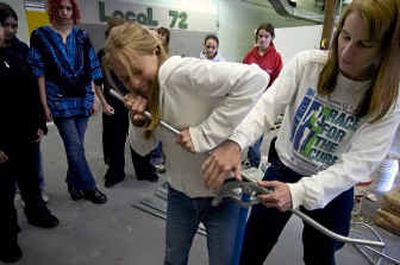Middle school girls learn about construction careers

“Carpentry is cool,” Alauna Stinson said.
You probably never thought you would hear a 15-year-old girl say that. But the Shaw Middle School student is already starting to think about a career, and someday she would like to build her own house.
Of course, she also doesn’t want to have to depend on a guy to fix her car for her, so carpentry may have to compete with auto mechanics for Stinson’s attentions.
She was one of 50 eighth-grade girls from three Spokane middle schools attending a half-day seminar on careers in construction at the Apprenticeship and Journeyman Training Center in Spokane Valley on Thursday. The center is a cooperative effort of Spokane Community College and 19 area apprenticeship programs.
Spokane Public Schools, CCS and the state’s Construction Skills Panel lured the girls with the promise of “pizza, pop and power tools.” They hope it will be the start of something beautiful.
At a time when 50 percent of the nation’s workforce is due to retire in the next five to 10 years, the federal Bureau of Labor Statistics expects a million construction jobs to open up by 2012. The construction industry is worried about finding enough people to fill jobs in “the trades.” Thursday’s seminar, a first for Spokane schools, was designed to interest young women in construction.
“These careers need the same high-caliber kids that any field needs,” said Tessa McCray, a Spokane School District spokeswoman.
The girls’ day began with a short film about careers in construction, the central theme of which was, “You don’t need a college degree to get a good-paying job.” In fact, the film claimed that of 100 college students today, only four will end up making more money than people in the trades.
Starting wages in construction range from $9 to $20 an hour for apprentices, according to information provided by the school district and colleges. Journeyman wages start as high as $40,000 a year.
But that does not mean you should give up on education. The construction industry is looking for workers with many of the same skills as any other profession: math, science and communication. The difference is the trades will pay you while you are learning, and you won’t end up with student loans to pay off, the students were told.
The girls heard from Lori Barrick, a member of the Spokane chapter of National Women in Construction, who joined the laborers to make the prevailing wage. She later started her own traffic control business. She said flaggers, who route traffic around construction sites, make $17.50 an hour, plus $6.50 an hour in benefits.
She’s proud, she said, of making part of history by helping to finish the North Idaho portion of Interstate 90.
“Don’t let being involved in a nontraditional role scare you,” Barrick told the girls. “It’s actually a lot of fun.”
Nine million American men and only 975,000 women work in construction, the students were told.
“We’re not going to hire someone just because you’re female, but we need women,” said Colleen Buckham, a journeyman electrician and instructor for the electrical apprenticeship program at the center.
She and Kevin Managhan, who directs the program for the Inland Empire Electrical Training Trust, said apprentices learn and work for five years before becoming a journeymen. They begin at more than $10 an hour and earn regular raises. Tuition and books cost $800 a year.
Out of 50 electrical apprentices last year, there was one woman, said Buckham, who was the first girl on the Kellogg, Idaho, baseball team, and the only woman electrical apprentice the year she entered the Spokane program.
Her advice to the girls: “Work on your math, because you’re not going to get into the program without it.”
Managhan explained that the Spokane School District has adopted a policy to include funding for apprenticeships in upcoming construction spending. This program also must make an effort to recruit women and minorities into the trades.
In 2003, Spokane voters approved a $165 million bond as the first phase of a 25-year plan to upgrade or replace old schools. Apprentices will be used in construction jobs to replace Lidgerwood, Lincoln Heights and Ridgeview elementary schools, in the renovation of Rogers High School and other school remodeling projects.
Applicants for these apprenticeships must be at least 18 years old, a high school graduate and must have passed the Washington Assessment of Student Learning.
One of the main goals of this program is to keep young people in Spokane.
Which brings us back to Alauna Stinson, who enters high school next year, plans to attend community college and may consider an apprenticeship in carpentry.
“I don’t want to move away from Spokane,” she said. “I love it here.”